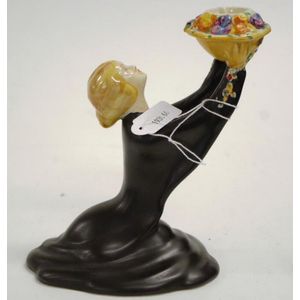
Clarice Cliff Bizarre Candlestick with 'Geometric' Pattern, 15cm Height
Clarice Cliff (British, 1899-1972), Bizarre candlestick, 'Geometric' pattern, printed factory mark to base 'Wilkinson Ltd England hand painted Bizarre by Clarice Cliff Newport Pottery England', minor loss of paint (A/F), height 15 cm. Provenance: Theodore…

Clarice Cliff 'Crocus' Candlesticks, c. 1931, 20 cm tall
Clarice Cliff (British, 1899-1972), Bizarre pair of candlesticks, c. 1931, 'Crocus' pattern, printed factory marks to bases 'Crocus hand painted Bizarre by Clarice Cliff Newport Pottery England', height 20 cm. Provenance: Private Collection, Sydney

Clarice Cliff Bizarre 'Inspiration' Candlestick in 'Caprice' Pattern
A Clarice Cliff Bizarre 'Inspiration' candlestick, 'Caprice' pattern, shape #310, height 7.7 cm, diameter 11.4 cm.

Clarice Cliff Bizarre 'Rudyard' Candlesticks, Stepped Shape #391, 8.6cm
A pair of Clarice Cliff Bizarre 'Rudyard' candlesticks, stepped shape #391, height 8.6 cm.

Clarice Cliff Aurea Candlesticks
A pair of Clarice Cliff candlesticks, in the Aurea pattern, printed marks to base. Height 7 cm.

Clarice Cliff Figural Candlestick with Suspended Blossom
Good Clarice Cliff ceramic figural candlestick depicting a woman in black robe holding a suspended blossom decorated candle holder, marked 'Clarice Cliff, Newport Pottery', to base, height 18 cm. Restored below basket.'.

Clarice Cliff Ceramic Candlestick with Suspended Blossom
Good Clarice Cliff ceramic figural candlestick depicting a Woman in black robe holding a suspended blossom decorated candle holder, marked 'Clarice Cliff, Newport Pottery,' to base, height 18 cm

Clarice Cliff Enamelled Porcelain Sir Frank Brangwyn Wall Charger
A large Clarice Cliff enamelled porcelain Sir Frank Brangwyn series wall charger, circa 1930's, signed and detailed to verso 'The Brangwyn panels designed for the Royal gallery of the house of Lords 1925, first exhibited at Olympia 1933, painted by…

Clarice Cliff Bizarre Diamond Candle Stand
A Clarice Cliff 'Bizarre' candle stand, stepped square form in a diamond type pattern. Shape 391. Height 8.5 cm.

Clarice Cliff Inspiration Candlestick
A Clarice Cliff candlestick, stepped square form in the Inspiration pattern, printed marks to base. 8.5 cm x 8.5 cm x 9 cm.

Clarice Cliff Bizarre Candlestick with Flowers and Black Band
A Clarice Cliff Bizarre 'Gay Day' candlestick, yellow band to top, white neck, flowers with black band detail, shape 310, marked to base, small chip to rim, height 7.5 cm

Clarice Cliff Geometric Candlestick (15 cm)
A Clarice Cliff 'Bizarre' geometric candlestick, height 15 cm

Clarice Cliff Bizarre Lydiat Candle Holders Set of Four
A set of four Clarice Cliff Bizarre 'Lydiat' candle holders, 6 cm square

Clarice Cliff Melon Candlestick with Fruit Detail
A Clarice Cliff Fantasque melon candlestick, orange top & neck, thin black band, fruit detail, shape 310, marked to base, height 7.5 cm

Rare Clarice Cliff Autumn Blue Candlesticks
A rare pair of Clarice Cliff tall candlesticks in the Autumn blue pattern, 12' tall in the Elton shape with tapering square section bodies decorated with houses nestled between and under ballooning trees, the circular nozzles and tapering bases in…

Art Deco Ceramic Candlesticks, Clarice Cliff Style
Pair Art Deco ceramic candlesticks. In the manner of Clarice Cliff. Unmarked. Hariline to top of one., height 12.5 cm

Clarice Cliff Bizarre Geometric Candlestick
A Clarice Cliff Bizarre tall column candlestick, the tapered square section column with circular nozzle and waisted spreading base in an original Bizarre geometric triangular pattern, gold printed mark to base, height 30 cm.

Clarice Cliff Candlestick Pair with Female Figure and Flowers
Clarice Cliff, pair of candlesticks, each in the shape of a female figure upholding a bouquet of flowers, one figure inscribed 'My garden' (2) one (A/F), height 18 cm. Provenance: The Estate of Ray Hughes

Clarice Cliff Arab Boy Candle Holder
Clarice Cliff, Bizarre' Arab Boy Candle Holder, c. 1933, Orange/Blue Chintz' pattern, printed factory marks to base 'Bizarre by Clarice Cliff Newport Pottery England, height 15 cm. Provenance: Private Collection, Sydney

Clarice Cliff Bizarre Garden Wares Set
Three Clarice Cliff Bizarre 'My garden' wares: a bowl, sugar shaker and a small Candleholder$1930-35, a tan drip glazed yellow bowl and a matching pillar shaker, both with moulded floral bases in exuberant colours; and a similar domed candleholder;…

Clarice Cliff Bizarre Pompadour Candlesticks
Clarice Cliff Bizarre 'Pompadour' pair of candlesticks stamped '776 Clarice Cliff Wilkinson Ltd England 'Pompadour''. Condition, good, minor wear to the bases. Dimensions, 13 x 5.6 cm

Clarice Cliff Sandon Ziggurat Candlestick - 9cm Height
Clarice Cliff Bizarre candle stick. Sandon ptn, Ziggurat shape. Height 9 cm

Art Deco Candlestick by Clarice Cliff
Clarice Cliff 'Erin Green' Art Deco porcelain candlestick, circa 1920s. 12.5 cm.

Clarice Cliff Melons Candlestick, 1930
A Clarice Cliff fantasque 'Melons' candlestick, English, circa 1930. 30 cm high

Clarice Cliff Candlestick with 'Secrets' Pattern
Clarice Cliff 'Fantasque Bizarre' candlestick, c. 1933-1937 'Secrets' pattern, printed factory marks to base 'Fantasque hand painted Bizarre by Clarice Cliff Newport Pottery England'. Height 22 cm

Clarice Cliff Bizarre Gay Day Candlesticks Pair
Pair of Clarice Cliff Bizarre Gay Day candlesticks, 8.5 cm wide, 4.5 cm high approx

Clarice Cliff Bizarre Diamonds Candlestick (30cm)
Clarice Cliff 'Bizarre' Diamonds candlestick, 30 cm high

Clarice Cliff Melon Candlestick
Clarice Cliff, 'Fantasque' candlestick, 'Melon' pattern, painted factory marks to base 'Hand Painted Fantasque By Clarice Cliff Wilkinson Ltd England', with impressed shape mark '331'. Height 5.5 cm




 Loading more...
Loading more...